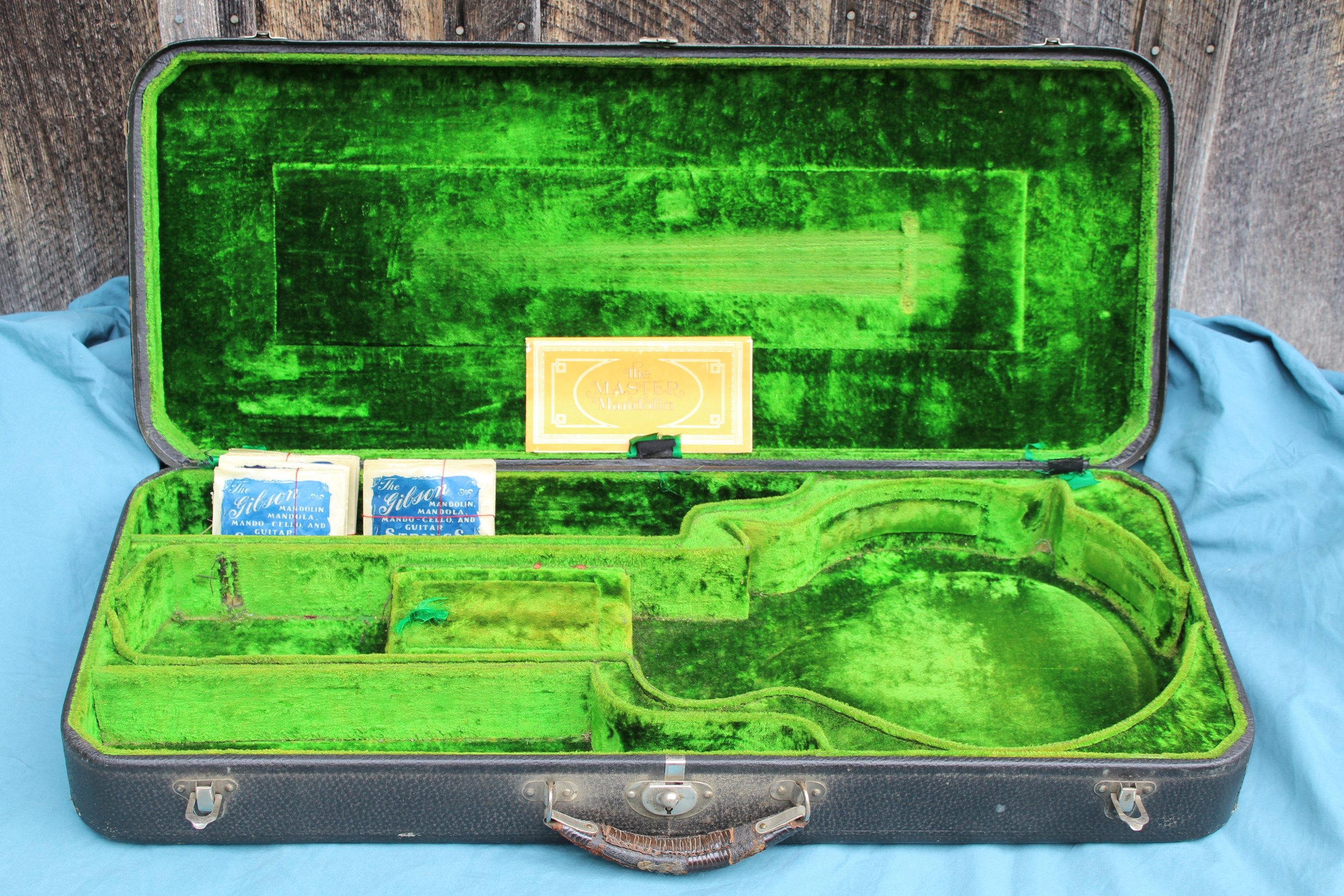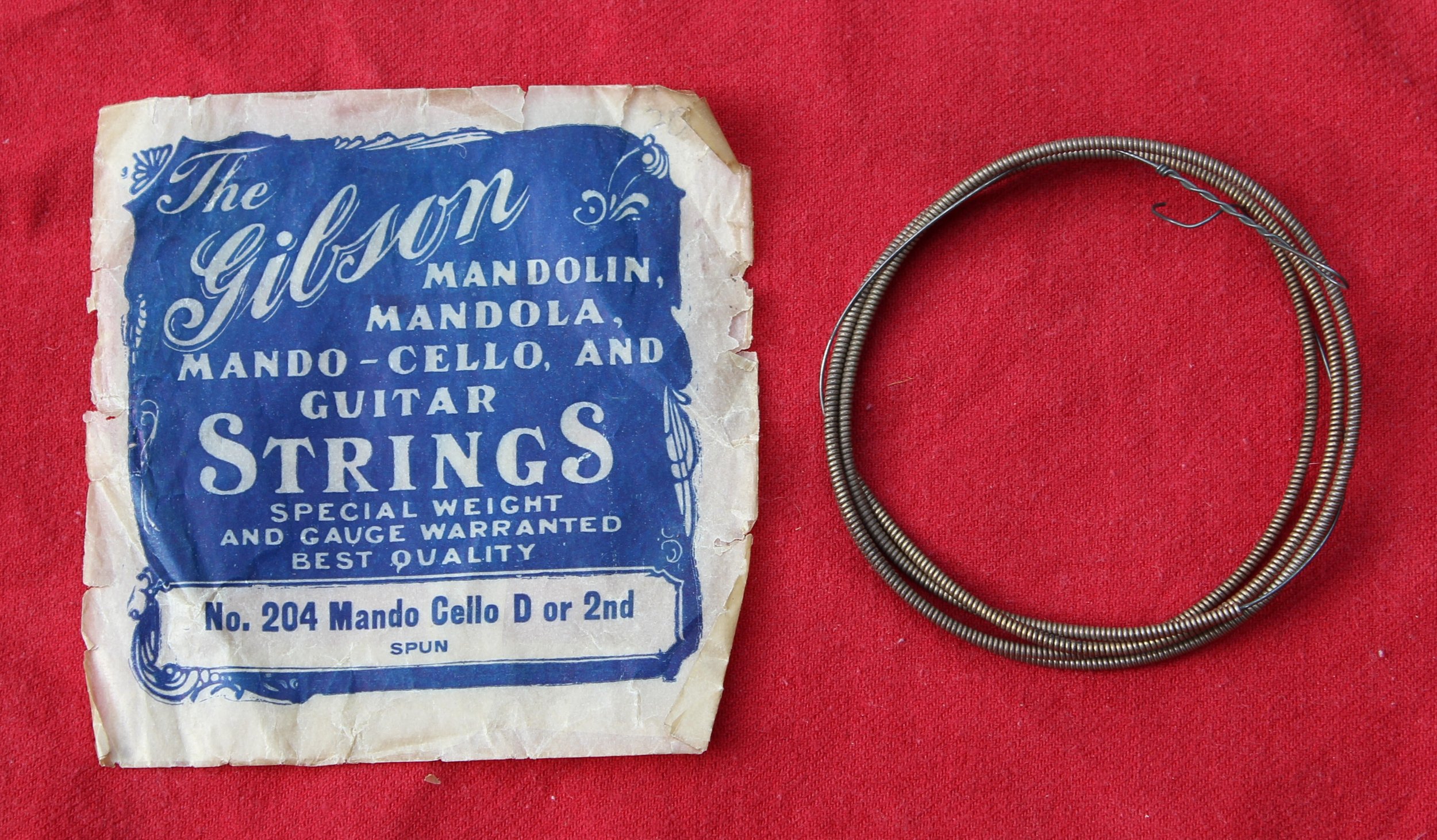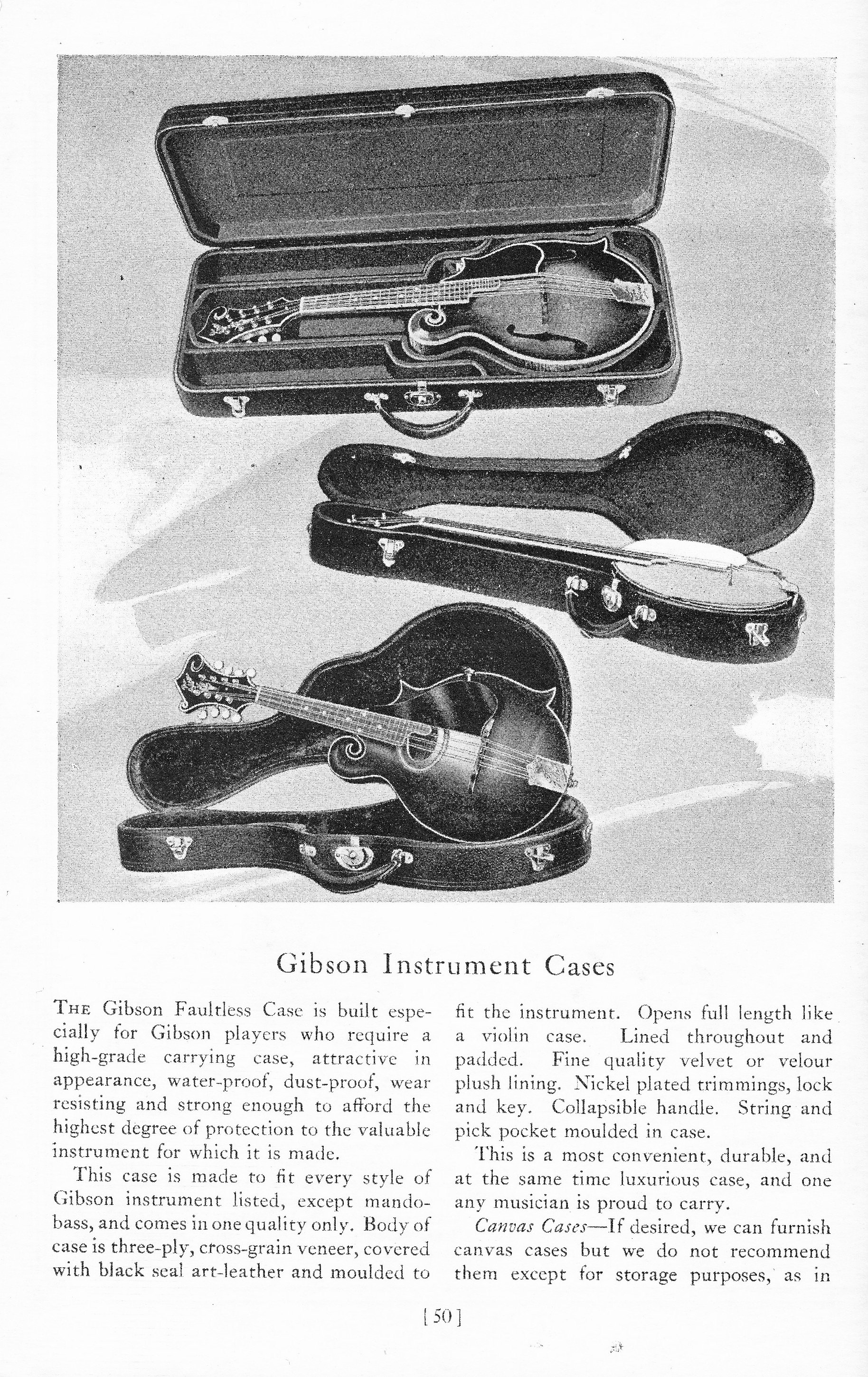1923 Geib and Schaefer case (listed in Gibson catalog N as “Faultless SP #440”), custom fitted for Gibson F-5 (strings and “Master Model” foldout flier included in photo). 1923 Gibson Service Manuel lists it in more detail: “440 Faultless, silk plush lined, combination case, compartments for music roll and rack, strings etc., F styles …$37.50.”
By May of 1922, fittings, such as tuners, tailpiece, pickguard, case, and even strings were of prime consideration. Style F-4 had been the flagship of the Gibson Mandolin and Guitar Company since the first listing of models in the 1903 catalog. Now, the look of style 5 must be distinguished from style 4. In the Guild Convention, in the press, and more importantly, in sales, Gibson’s prominence as the leader among musical instrument merchandisers had been seriously challenged. Model F-5 was their answer, intended to attract national attention as an astounding upgrade in sound, finish, construction and playability. Clearly, the fittings must reflect a status befitting the “top-of-the-line” Master Model.
Silver-plated, engraved tailpiece covers for Gibson F-5s. Left to right: February 26, 1923; July 9, 1923; February 18, 1924.
The tailpiece base was identical to most other models, except silver-plated; cover was to be hand engraved and silver plated.
Pickguard or finger rest: Since 1909, Gibson had demonstrated the benefits to tone and volume from elevating the pickguard above the mandolin sound board; style 5 would be updated and upgraded yet again.
Patent for elevated “finger rest” granted to L. A. Williams March 30, 1909, using a standard violin chin-rest mounting bracket.
The clamp-style finger rest attachment (patent granted to G. D. Laurian on July 4, 1911) used on most Gibson models from 1911 until 1922.
Artist model pickguard and attachment bracket on 1922 Gibson H-4 Mandola.
Bound celluloid pick guard complementing body contour became standard on style 5 by the end of 1922. Patent date remained March 30, 1909.
Mounting bracket attached with nickel-silver plated rod, threaded on both ends. One end received in a celluloid mounting block under the guard while the other was passed through bound celluloid, capped, and affixed to the rim with a distinctive silver plated screw and washer.
Geared tuning machines: Beginning as early as 1904, the Louis Handel Company of New York supplied Gibson with geared tuning machines. Handel tuners can be identified by the characteristic wavy-end base plates and in the more expensive versions, tuner buttons with delicately inlays: four silver wire branches terminating in gold-leaf finials emanate from the center, a tiny pearl inlay of various shapes including dot, diamond and bird. Labor shortages for Handel in 1918 greatly slowed production, and by 1923 they were out of business.
Left: Handel tuners with pearl dot center, gold leaf and silver wire inlay on ivoroid buttons (15/16 post spacing);
Right: Geared tuning machines for 1923 F-5, silver plated, pearl buttons and engraved plate (29/32 spacing)
There were reasons other than the loss of supplier to redesign mandolin tuners. “Tone color is determined by the number, identity and proportion of the overtones or partials present in the tone of the instrument…The further away the overtone is from perfect consonance, the more richness and less brilliancy the overtone adds” (“A Talk About Tone,” Lloyd Loar, Master Model foldout leaflet). Placing the tuner plates so that all the strings are free to vibrate between the nut and tuner post would also contribute to Loar’s definition of richness. To achieve this, new designs would be required. The solution for the A model was the “snakehead” peghead.
1922 Gibson A-4 with wavy-end tuners and standard peg head shape. Notice several strings are touching each other between the nut and the tuner post.
Newly designed “snakehead” peg head: all strings are free to vibrate from tuner post to nut.
The transition to new geared tuners was more complicated for the F-5; it took almost a year for the various problems to be resolved.
1922 Gibson F-5 # 71633, front and back. Notice the problematic placement of the wavy-end tuners as used on style F-4 when installed on the F-5 peg head: tuner plates overlap the peghead scroll cutout; the top G string button is crowded close to the side of the peghead making turning difficult, and several strings touch between the nut and tuner post.
Early 1923 tuners, 15/16 spacing. The new arrow-end tuners solve the problem of the plate overlap and the buttons are clear enough to turn. However, the post for the top D string goes through the “G” of the logo and the G strings still touch between the nut and the post of the bottom G string.
From 1904 until 1923, the measurement from center to center of the string post for the tuners on all Gibson mandolins was approximately 15/16. By the summer of 1923, this distance was shortened to 29/32, resolving the problems; inlays were not violated, plates did not overlap, all buttons were free to turn and the strings were free to vibrate from nut to string post.
Gibson F-4 from July 9, 1923, with tuner post spacing of 29/32. Both desired placement and Loar’s harmonic richness were achieved.
Strings: Wound “The Gibson” strings were spun with Monel, an alloy of nickel and copper, with over 50% nickel, less than 50% copper and small elements of iron, manganese, etc. First created in 1905 by Robert Crooks Stanley while working for the International Nickel Company of Toronto, Ontario, Canada, Monel was based on the same proportions of nickel and copper found naturally in meteoritic nickel ore from the Sudbury mines, also in Ontario, Canada. Monel was an attractive alloy for many uses because of its resistance to corrosion. By 1923, Gibson released a set of strings whose winding consisted of an alloy that replaced most of the copper with silver, advertised to give a “more lustrous sheen and sound.” Gibson also advertised a set with unwound stings of an alloy with a high percentage of copper.
“The Gibson” mandocello strings circa 1916: spun single strand windings with meteoritic-formula Monel; long lasting, buzz free strings.
“The Gibson” mandolin strings circa 1923, wound with a nickel/silver alloy for a “more lustrous sound.”
Of course, no Master Model mandolin would be complete without the “Faultless" plush lined case by Geib snd Schaefer of Chicago, Illinois.
Gibson catalog “N” from 1923, p. 50.
Close the latches and head home with your F-5 tucked away in a “Faultless” plush-lined case!
Next Episode: June 1, 1922 Centennial!

















